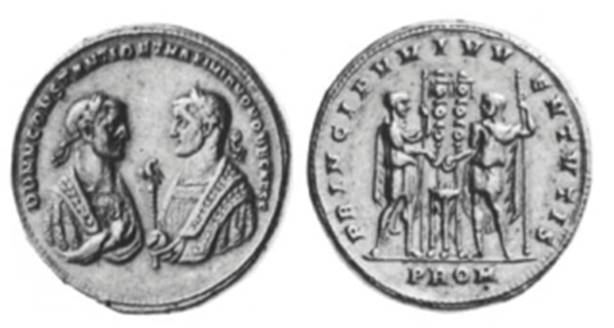Medallion of Constantius and Galerius. Rome, 293. Gold. Medallion of Galerius Maximian
OBV: DD NN CONSTANTIO ET MAXIMIANO NOBB caess (Dominis nostris Constantio et Maximiano nobilissimis caesaribus). Confronted busts of Constantius (on left) holding globe surmounted by Victory and Galerius (on right) holding eagle-tipped scepter; both laureate and wearing imperial mantle.
rev: principvm ivventvtis. The two Caesars standing in military dress sacrificing over altar; behind, two military standards. In exergue, p(ercussa) ROM(ae)

This piece is of the same weight as no. 31, but its smaller, thicker flan and lower relief detract somewhat from its medallic character. The busts are much smaller in relation to the field and hence less imposing than those of no. 31. Despite the wear on the reverse, which celebrates the Caesars as princes of youth, the two bearded figures are recognizable as Constantius and Galerius; this is not always the case, since many medallions bearing this type (which is confined to gold multiples) were designed for presentation to the noble youth of the city and thus bore only idealized figures.
The piece was produced at the mint of Rome. The unusual use of a dative obverse inscription— a dedication to the Caesars—suggests that it was issued soon after their elevation in 293. Constantius, whose elevation took place two months earlier than that of Galerius, occupies the position of seniority on the left.
Like no. 31, this medallion was part of the great Arras hoard, found in France in 1922. Formerly in the E. T. Newell collection.
Bibliography: Baldwin, 1926, no. 1; Toynbee, 1944, pi. 9, 4; Fagerlie, 1969, no. 25.
Medallion of Galerius Maximian. Antioch, 293. Gold. obv: GAL(erius) VAL(erius) maximianvs NOB(ilis) CAEs(ar). Bust of Galerius laureate facing right and wearing cuirass and paludamentum seen from behind.
rev : iovi cONs(ervatori) CAEs(aris). Jupiter naked with mantle behind him facing left holding a thunderbolt in right hand and with left leaning on long scepter; to left, an eagle looking back at him. In exergue, s(acra) M(oneta) A(ntiochensis)

The portrait of Galerius is rendered in the severe style popular in the East at this period, which is characterized by arched brows, enlarged eyes, and well-defined hairline. In contrast, the figure of Jupiter is finely wrought: the god stands in a relaxed posture, and the fine working of his hair and beard give him a realistic aspect seldom encountered in contemporary Eastern art or coinage.
Galerius' elevation to the rank of Caesar was probably the occasion for the issue of this medallion. The dedication to "Jupiter, the preserver of Caesar," was particularly appropriate, since Diocletian had conferred upon Galerius the title "Iovius"; a parallel issue was struck for Con- stantius, who bore the title "Herculius," with the inscription HERCVLI CONS CAES.
This piece was found during excavations near Alexandria in 1942, together with no. 35 and a medallion of Delmatius Caesar. Bibliography: Bellinger, 1958, no. 4.
Date added: 2025-07-10; views: 135;
